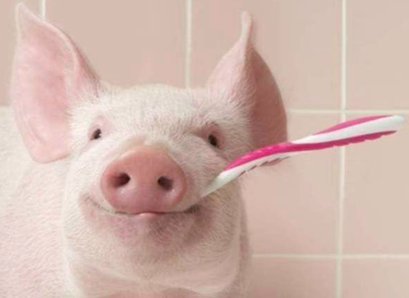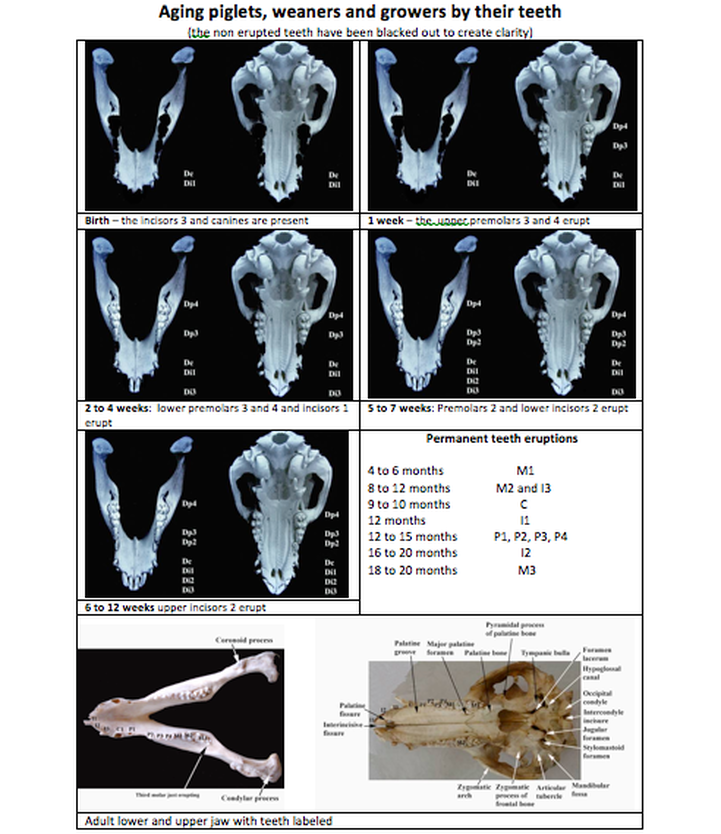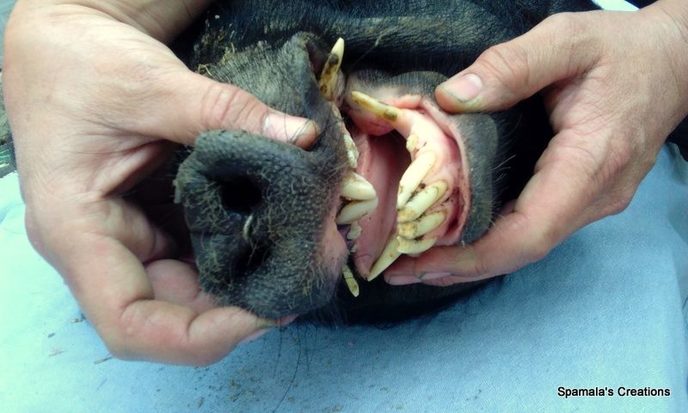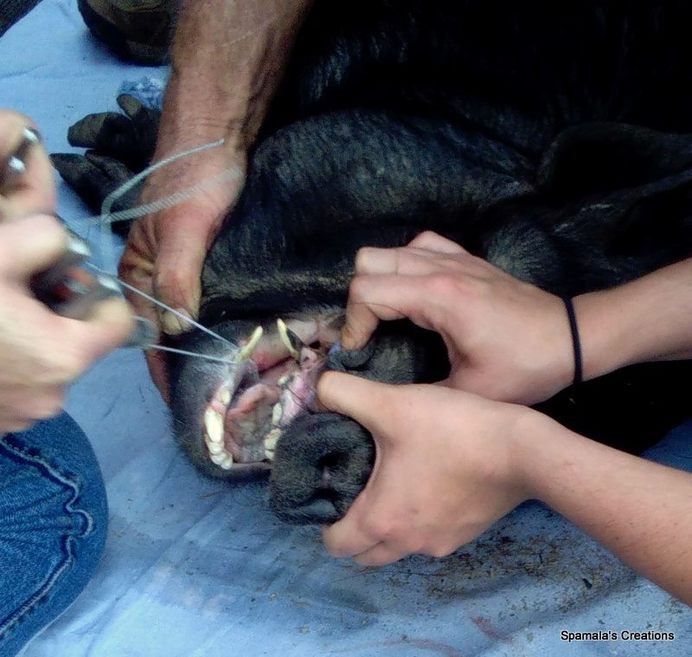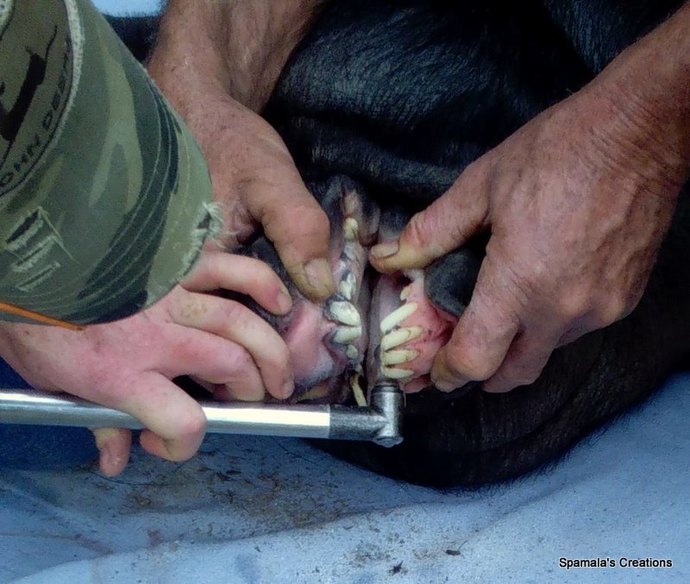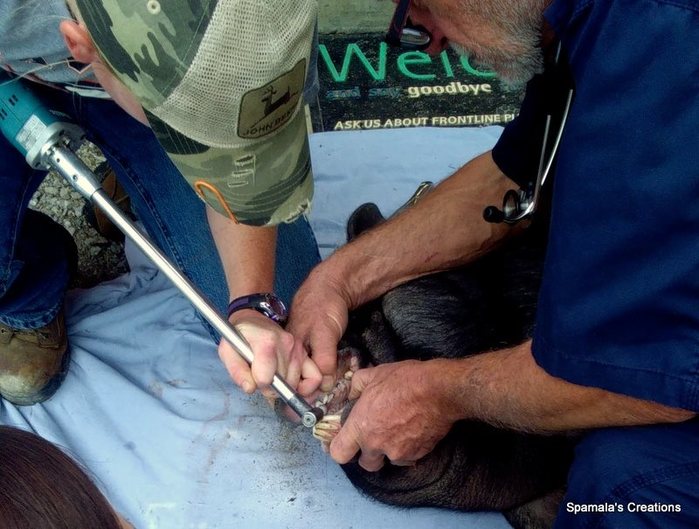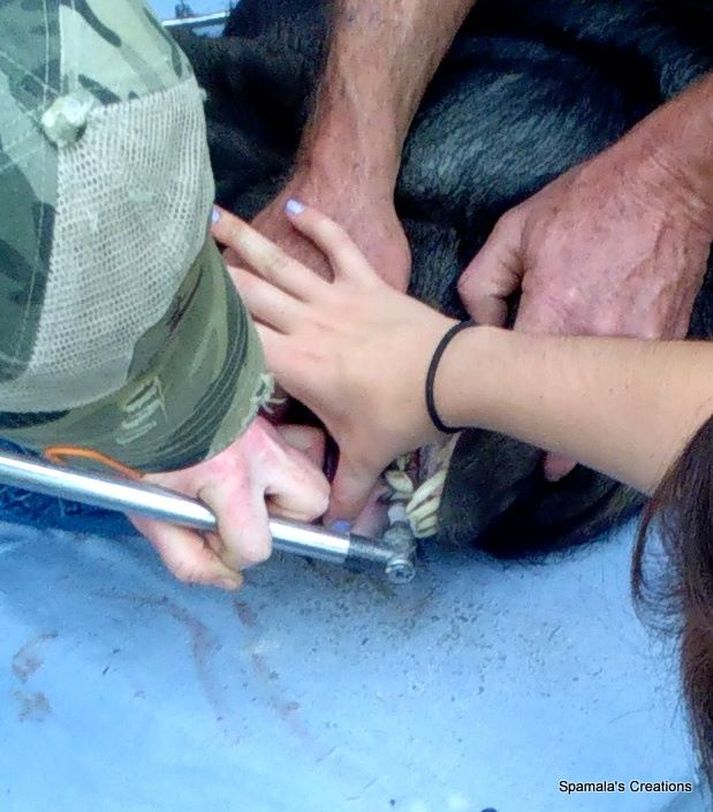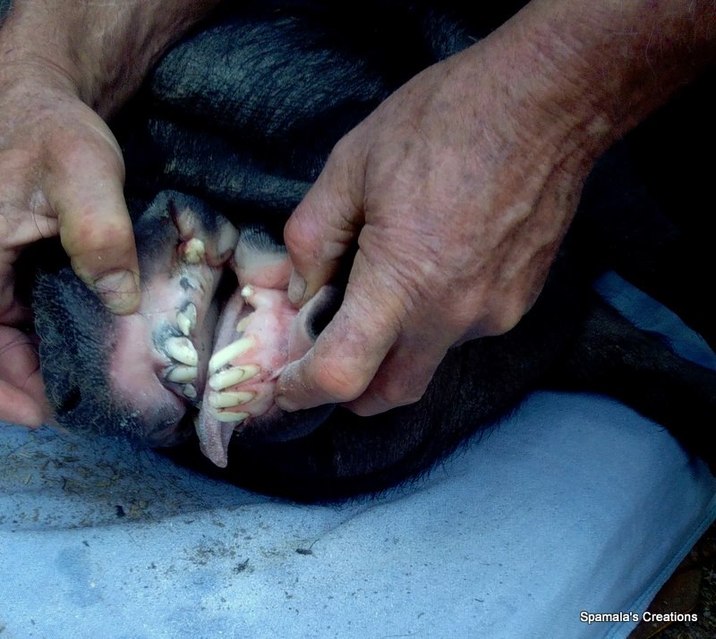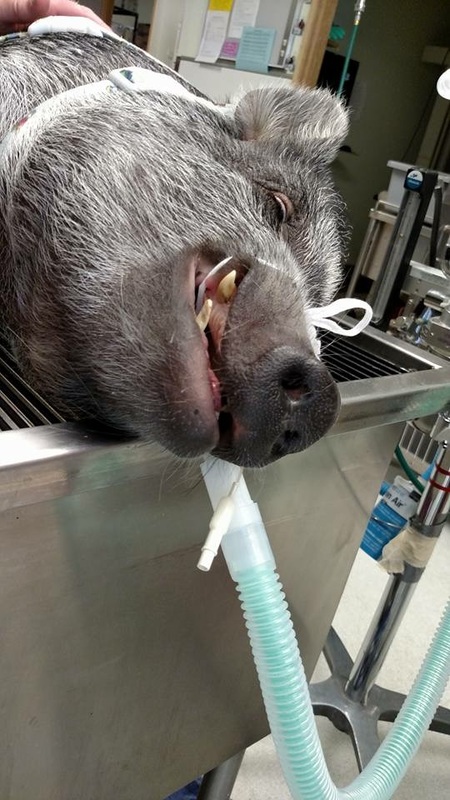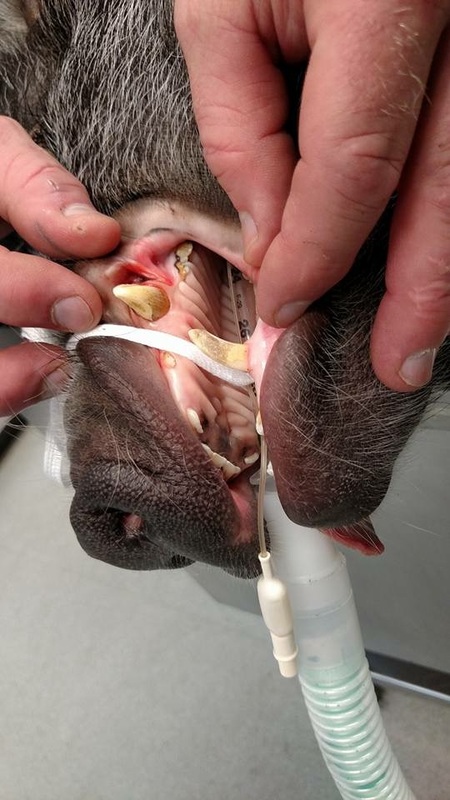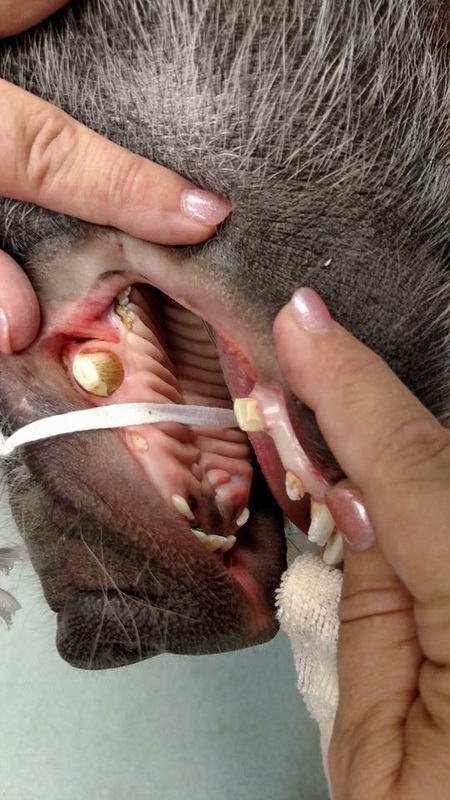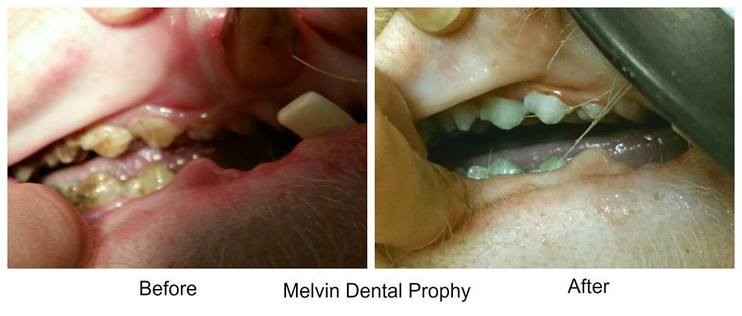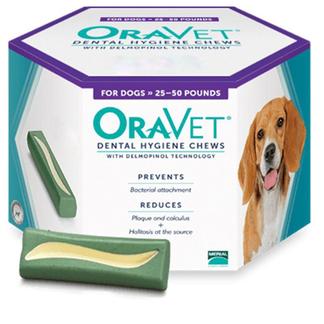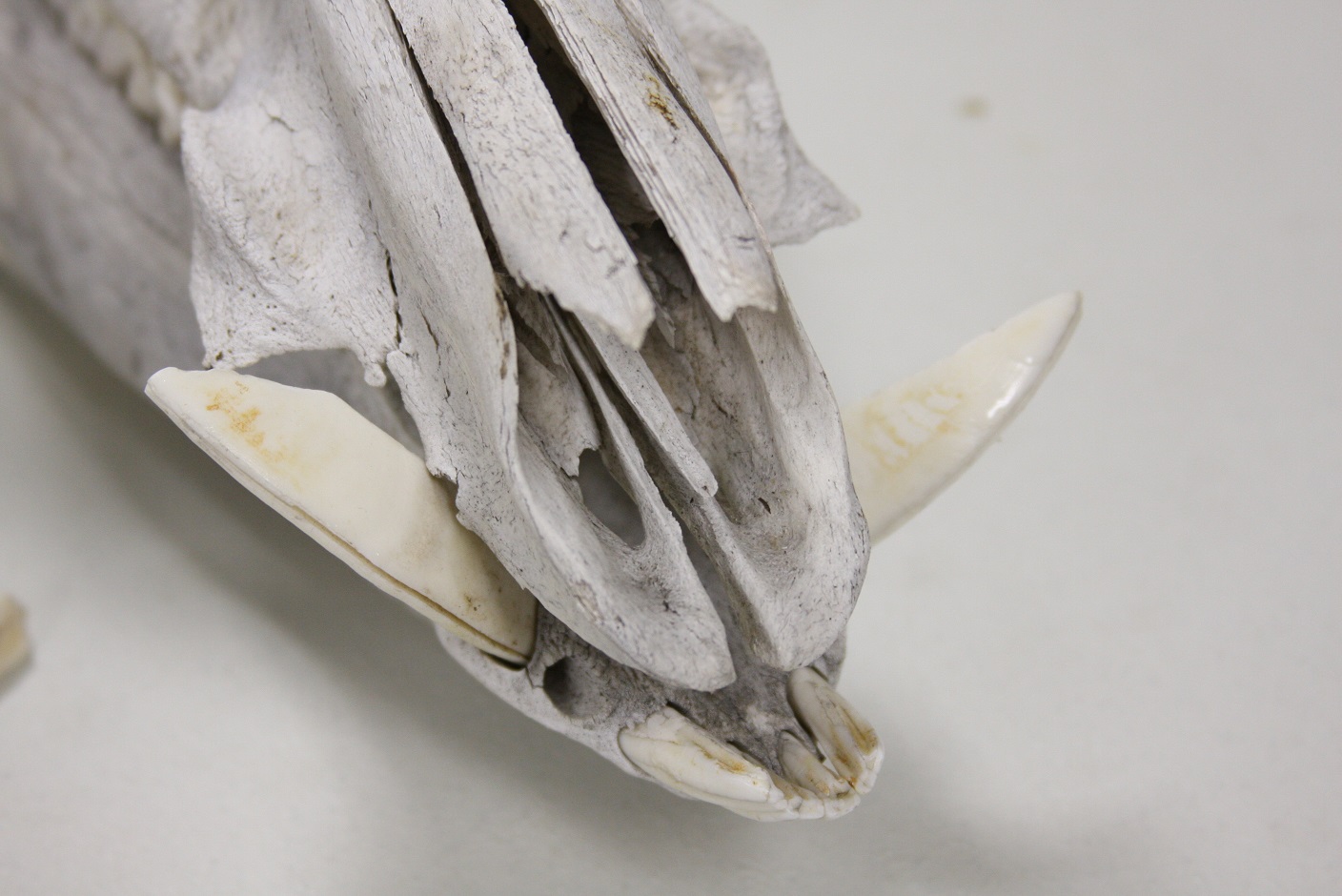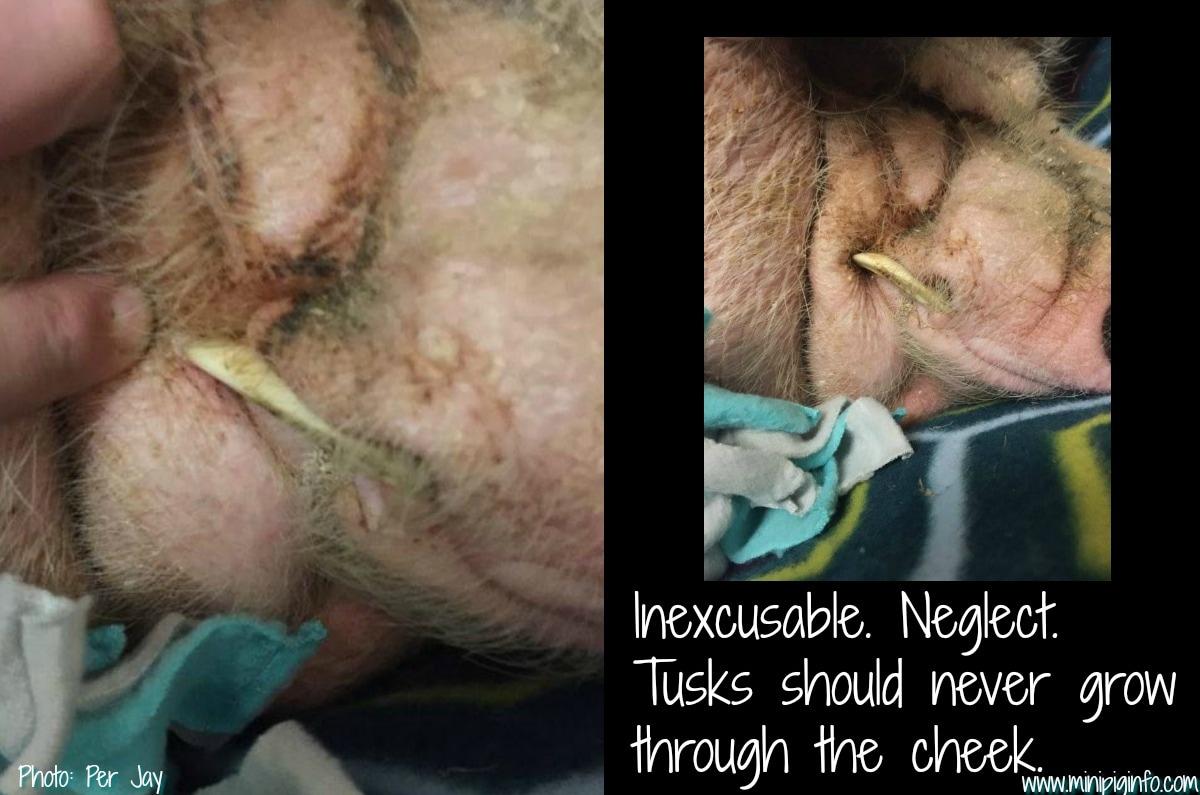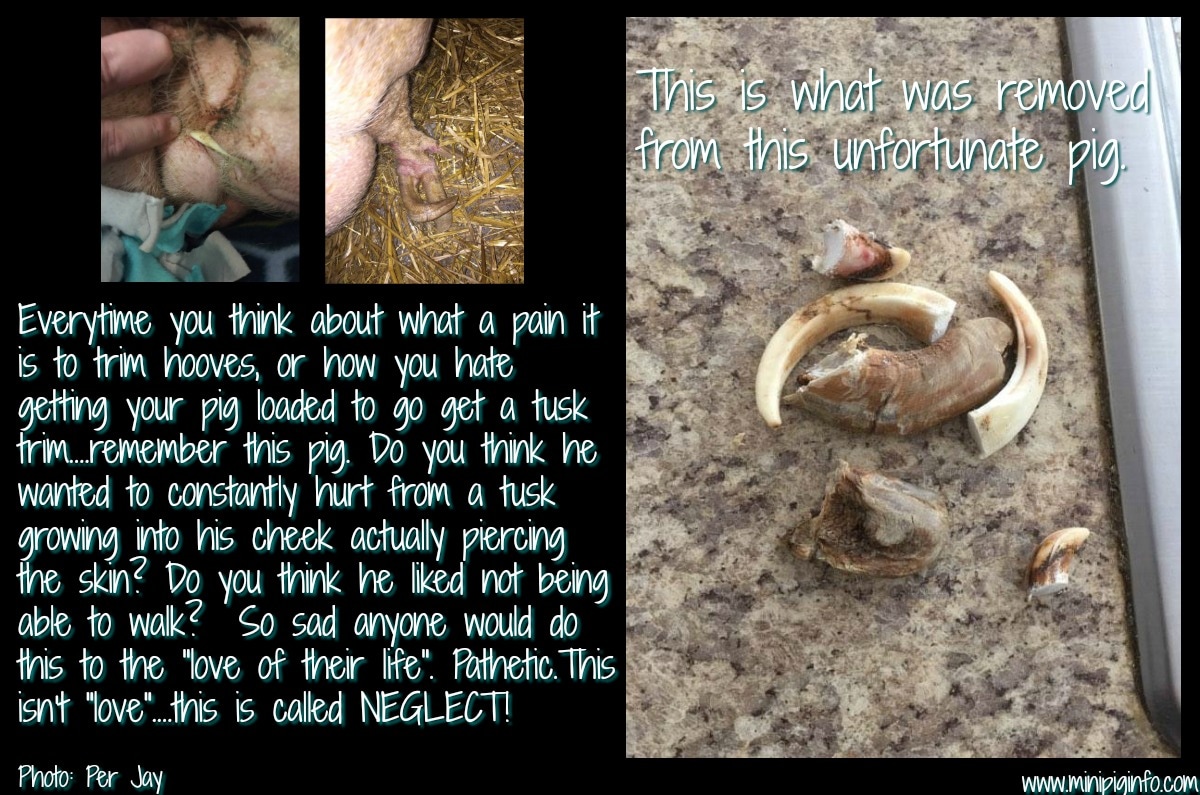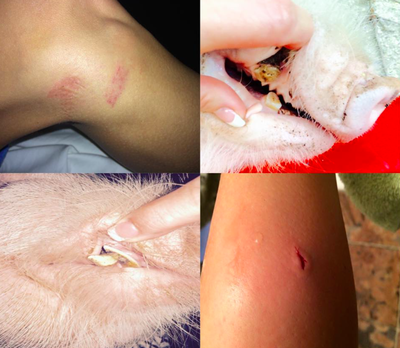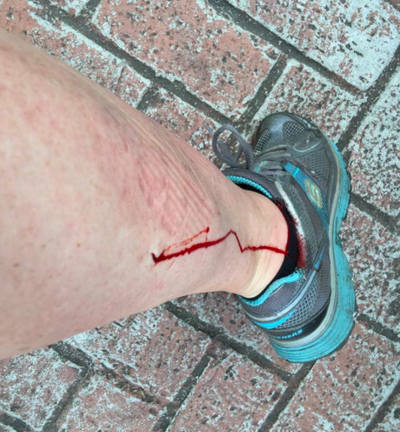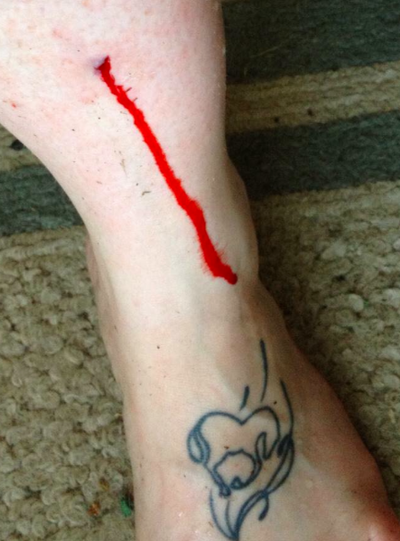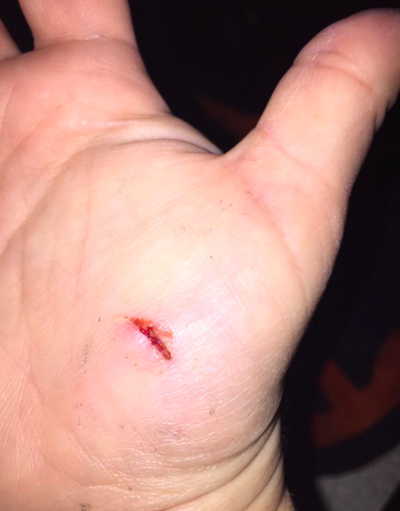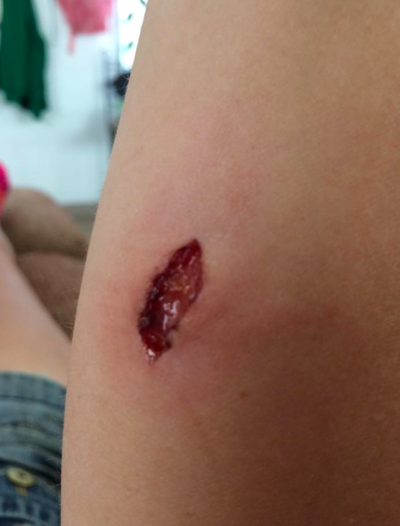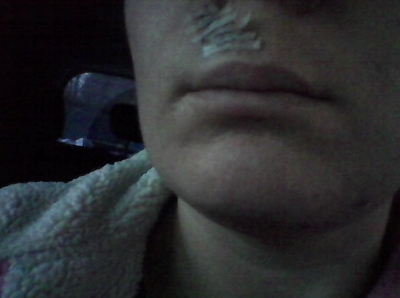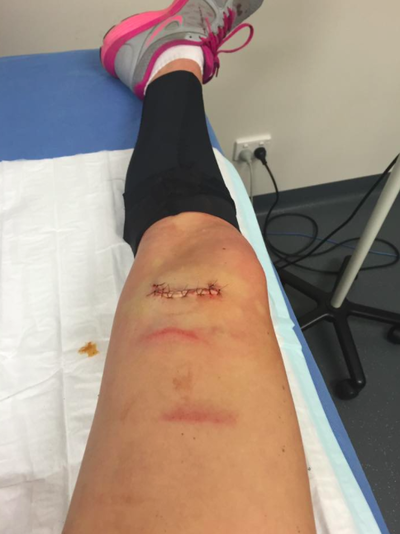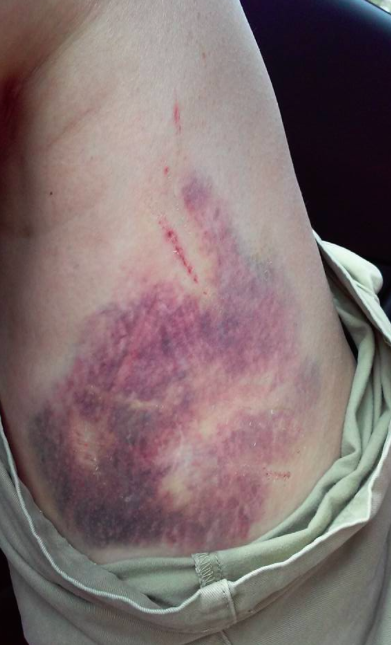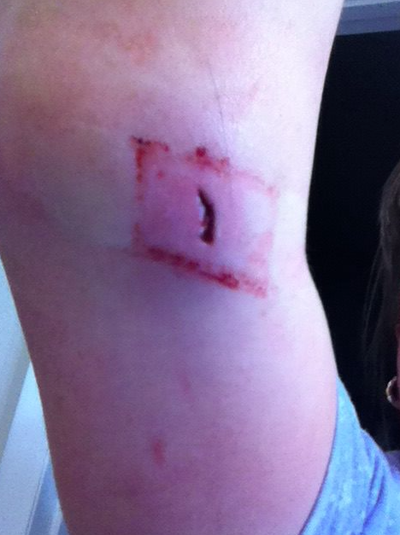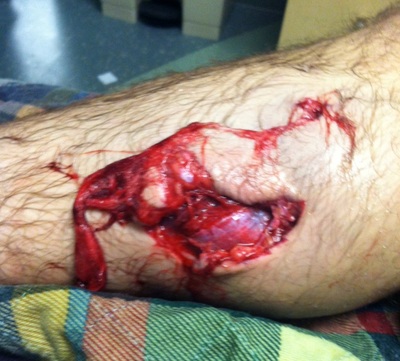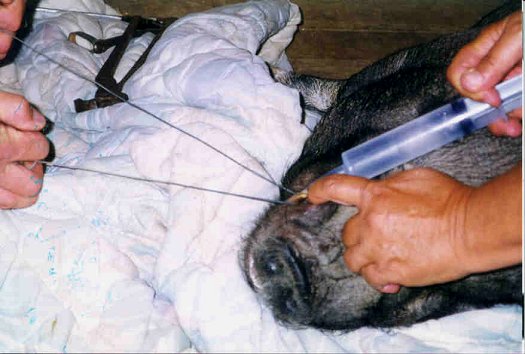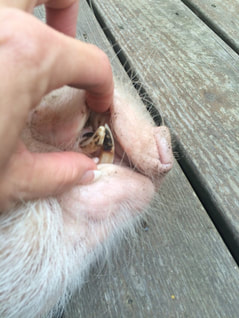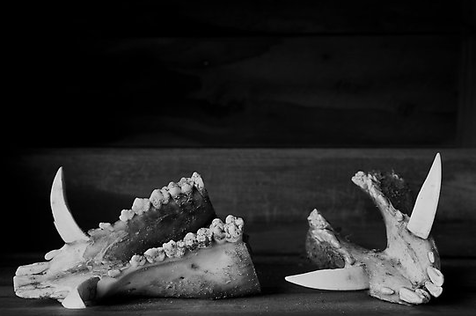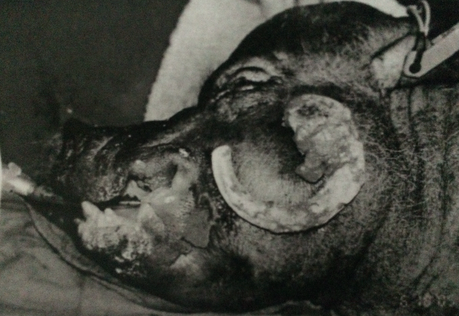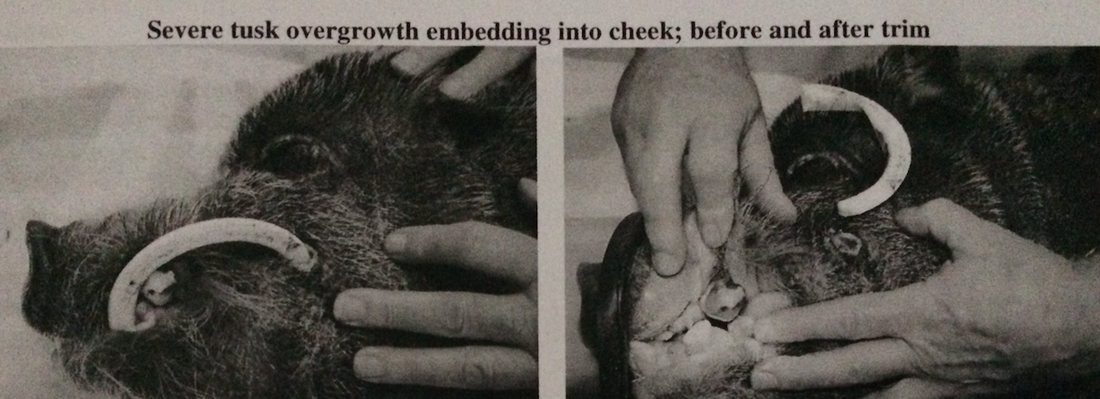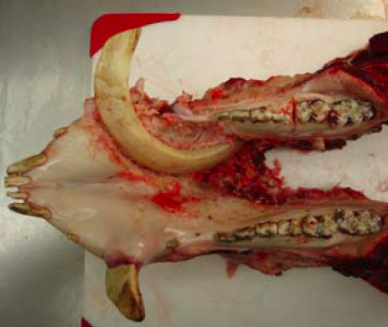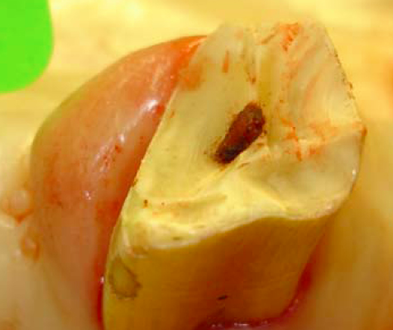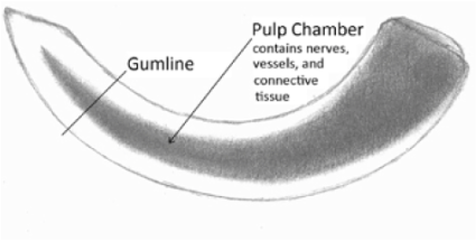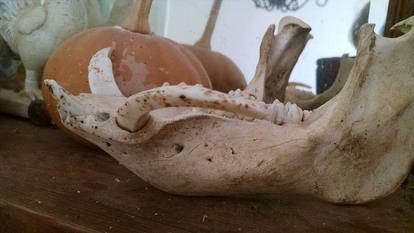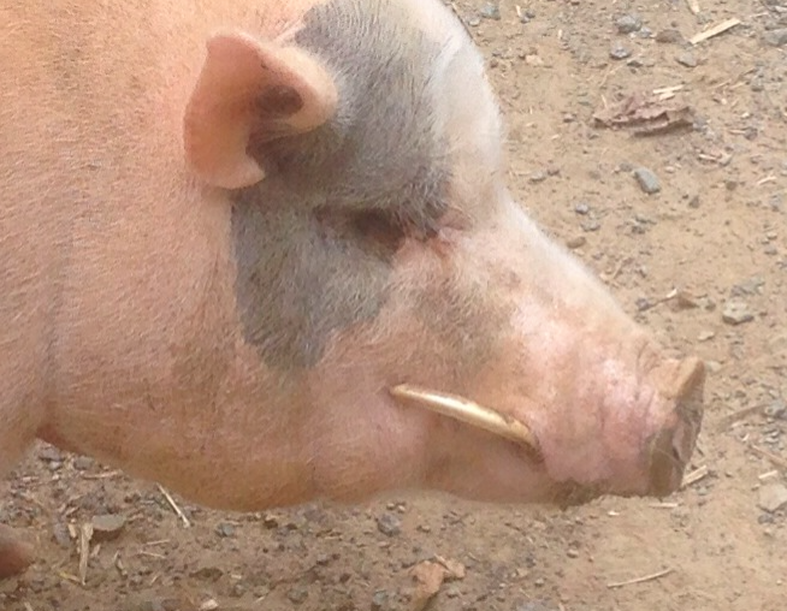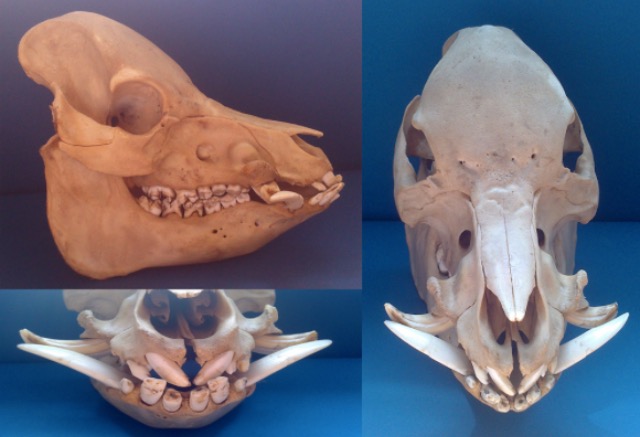Mini Pig Dental Information
Basic Dental Anatomy And General Care
Dental Care
**First things first, please be sure to regularly check your pigs mouth, teeth and gums. Make it a habit of putting your fingers in his or her mouth when they're young so that its not a big production when they're bigger and older to look inside their mouth or inspect their throat and/or teeth**
Dental care is extremely important for potbellied pigs. Newborn pigs should have their 8 needle teeth trimmed to prevent injury to litter mates and cuts on their mother's breasts and underside. However, this typically occurs prior to a pig coming to a new family and if they are not trimmed, you should not trim them after they've been weaned and they're eating solid food. At about 5 to 7 months of age, the permanent canine teeth will erupt, this can vary from pig to pig though. These "canine" teeth, otherwise known as tusks, grow continuously throughout a pig's life. If the tusks are growing at an angle that is causing pain, upwards towards the top lip instead of outwards, causing injury to you and/or your pig, or the tusks are getting caught on fencing, etc, it may be a good idea to consider a tusk trim. Normally, they will be first trimmed at after 1 year of age and then trimmed on an "as needed" basis. It is recommended that the tusks NOT be trimmed, when possible, because trimming the tusks opens the possibility for a tusk root infection/tooth fracture which can later lead to serious health complications. For some pigs, without trimming, the canine teeth will become elongated and cause discomfort and sometimes even a misaligned bite. Pigs with elongated canine teeth may show persistent chewing motions and heavy salivation. Tooth trimming requires sedation or anesthesia and is often accompanied by a tetanus vaccination and removal of accumulated tartar and other debris from around other teeth to maintain good dental hygiene. They have a total of 44 teeth. Most pigs are at least 1 ½-2 years old before the permanent teeth are all in and this can even vary from pig to pig.
Elderly potbellied pigs may have abscessed and/or exposed roots with decayed teeth. An x‑ray may be required to diagnose dental root problems. Extraction of abscessed teeth may be necessary. Most potbellied pigs respond well to extractions and recover rapidly with the help of antibiotics and tetanus shots. Usually, the first signs of major tooth decay are your pig going off the feed, maybe even rubbing the cheeks on objects often. Be sure to routinely check the breath. Because we often advise people to wet the pelleted feed before giving it to their pig, we are also preventing the harder pellets from naturally scraping off tartar from the teeth leaving them more at risk for decay and cavities. If you can, use an appropriate, vet recommended product to help facilitate cleaning of the teeth or balance the pH in the mouth which can help to prevent decay. If your pig will let you brush their teeth, we would recommend doing that. But definitely keep in mind that not providing a harder substance to chew does put your pig at a greater risk of having plaque buildup and the problems that follow poor oral hygiene.
Teeth grinding in potbellies can be extremely annoying, it can sound like crushed rocks being ground together. Teeth grinding is common and may not indicate pain, hunger or distress. Edible treats should not be used as rewards as the pig may become obsessive. In the wild, pigs grind their teeth to sharpen them with male pigs sharpening their tusks in this way. So in this sense, it’s perfectly natural for a pig to grind his teeth. In my experience, pigs grind their teeth for many reasons, some is habit, some is sharpening their tusks, other times its because there is an issue with the teeth or jaw causing discomfort. Always check your pigs teeth and gums for any sign of disease/abscess. Include this in your daily routine/health inspection and after doing it for a while, your pig won't be hesitant to allow you to check the teeth and gums. Do NOT do this for a pig that's unfamiliar with you. A scared pig can and will bite, and based on the size of the tusks, this can lead to serious infections if the pig "tusks" you accidentally or on purpose. This can cause localized or blood infections in people or animals that your pig "tusks" or bites. So keeping the tusks at a manageable length can prevent this kind of injury to yourself, other people or pets.
A domesticated pig will grind their teeth for a few reasons. If they are around 2 years of age, your pig could be teething and once that’s finished the grinding should stop or at the very least reduce. Your pig could also be distressed for some reason, so you might want to make sure that there hasn’t been any major changes in your piggie’s life or anything that might make your pig stressed for some reason. Remove the source of the stress and the grinding should cease. A third reason is that your pig could simply be happy and content! If this is the case, sadly there’s not much you can do to stop the grinding directly. There are situations where there may be a piece of food or dirt/foreign material that is causing discomfort and therefore the pig is grinding the teeth to try and dislodge the material. There have been times where there was an infection or abscess causing the pig to grind its teeth, so be sure to check the mouth and gums for abnormalities before writing it off to teething or something else that wouldn't cause much worry.
You can try to lessen the effect of the grinding by giving your pig a soft toy to chew – some of the dog chew toys can be quite useful for this purpose. Keep in mind, you must inspect chewed toys to be sure your pig isn't swallowing parts of the product that can lead to obstructions of any kind. But, at least your pig doesn’t bark....it’s a much more annoying trait. Choose dog treats carefully as some have been known to create a choking hazard and shouldn't be given to a pig who simply swallows food without chewing. There has also been cases where dog treats have caused abscesses in the esophagus of pigs due to the hard shell of the treat and the jagged edges when chewed. We do not recommend dog treats be given to pigs for the most part. The body's enzymes used to breakdown food aren't effective on synthetic treats and sometimes they can get lodged in the throat or even swallowed and cause intentional blockages. Whimzees have been named the treat of choice for many pig parents for dental purposes. Greenies have been known to include an ingredient that may be harmful to pig, so stay away from that particular brand. (I do not have the information to support that, but it is better to be safe rather than sorry) But be sure your pig is a chewer, not a swallower. Pigs that tend to swallow and not chew their food don't necessarily benefit from the use of these treats as they're used to help reduce the amount of plaque buildup on the teeth. If your pig swallows this whole, it can get lodged on the throat or cause an obstruction. You will know your pig better than anyone else, so watch them eat one before providing them on a regular basis to be sure they're chewing before swallowing. Whimzee's have come the treat of choice for mini pigs. I use Oravet chews which do not pose the same risk for choking as some of the others do.
If you'd like to learn more about the dental anatomy of pigs, here is a link to one of the universities websites regarding pigs teeth as well as pictures of the various angles of the jaw. http://www.vivo.colostate.edu/hbooks/pathphys/digestion/pregastric/pigpage.html
Dental Care for Veterinarians
The 8 needle teeth (4 deciduous lateral incisors and 4 deciduous canines) of newborn PBPs should/can be trimmed to prevent injury to litter mates and laceration of the sow's underline. Four permanent canine teeth erupt at ~5–7 mo of age and are first trimmed at or after 1 yr of age, IF NEEDED. Elongated permanent canine teeth may cause discomfort, malocclusion, and persistent chewing motion and salivation. In PBPs, the canine teeth grow continually and should be cut only if needed, usually once a year, using obstetrical wire, mechanical saws, or other instruments. Do not use nippers to trim tusks. The risk for tooth fracture is much higher and the use of tools like nippers can cause micro fractures which later can lead to tusk root infections. Sedation or anesthesia is required. Teeth should NOT be cut as close as possible to the gum line without cutting the oral mucosa or lips; they should be cut in an angle to facilitate the growth outwards and at least 1/2 inch left visible; there should be no exposed root canal after cutting the canine teeth of any type of swine. Tetanus antitoxin (500–1,500 U, depending on PBP size) and antibacterials are usually administered. In PBPs properly vaccinated with tetanus toxoid, a tetanus antitoxin injection is unnecessary. Tartar buildup can be removed manually by instrument scraping at the same time the canine teeth are cut. Dental cleaners for small animals may be used with care, positioning the head of the PBP downward during use to prevent water aspiration.
Geriatric PBPs may have abscessed and/or exposed tooth roots; sedation and examination of the oral cavity with or without endoscopy is indicated if anorexia and/or bruxism are reported. Radiographs may be necessary to diagnose tooth root abscessation. Swelling followed by a draining tract at the angle of the mandible, especially in geriatric PBPs, indicates canine tooth abscessation. Removal is challenging even for skilled surgeons and may result in mandibular fractures. However, PBPs seem to recover well after tooth extraction followed by antibiotics and tetanus prophylaxis.
Posted by Brittany Kyanne (click here for original post)
Source: http://www.merckmanuals.com/vet/exotic_and_laboratory_animals/potbellied_pigs/management_of_potbellied_pigs.html.
**First things first, please be sure to regularly check your pigs mouth, teeth and gums. Make it a habit of putting your fingers in his or her mouth when they're young so that its not a big production when they're bigger and older to look inside their mouth or inspect their throat and/or teeth**
Dental care is extremely important for potbellied pigs. Newborn pigs should have their 8 needle teeth trimmed to prevent injury to litter mates and cuts on their mother's breasts and underside. However, this typically occurs prior to a pig coming to a new family and if they are not trimmed, you should not trim them after they've been weaned and they're eating solid food. At about 5 to 7 months of age, the permanent canine teeth will erupt, this can vary from pig to pig though. These "canine" teeth, otherwise known as tusks, grow continuously throughout a pig's life. If the tusks are growing at an angle that is causing pain, upwards towards the top lip instead of outwards, causing injury to you and/or your pig, or the tusks are getting caught on fencing, etc, it may be a good idea to consider a tusk trim. Normally, they will be first trimmed at after 1 year of age and then trimmed on an "as needed" basis. It is recommended that the tusks NOT be trimmed, when possible, because trimming the tusks opens the possibility for a tusk root infection/tooth fracture which can later lead to serious health complications. For some pigs, without trimming, the canine teeth will become elongated and cause discomfort and sometimes even a misaligned bite. Pigs with elongated canine teeth may show persistent chewing motions and heavy salivation. Tooth trimming requires sedation or anesthesia and is often accompanied by a tetanus vaccination and removal of accumulated tartar and other debris from around other teeth to maintain good dental hygiene. They have a total of 44 teeth. Most pigs are at least 1 ½-2 years old before the permanent teeth are all in and this can even vary from pig to pig.
Elderly potbellied pigs may have abscessed and/or exposed roots with decayed teeth. An x‑ray may be required to diagnose dental root problems. Extraction of abscessed teeth may be necessary. Most potbellied pigs respond well to extractions and recover rapidly with the help of antibiotics and tetanus shots. Usually, the first signs of major tooth decay are your pig going off the feed, maybe even rubbing the cheeks on objects often. Be sure to routinely check the breath. Because we often advise people to wet the pelleted feed before giving it to their pig, we are also preventing the harder pellets from naturally scraping off tartar from the teeth leaving them more at risk for decay and cavities. If you can, use an appropriate, vet recommended product to help facilitate cleaning of the teeth or balance the pH in the mouth which can help to prevent decay. If your pig will let you brush their teeth, we would recommend doing that. But definitely keep in mind that not providing a harder substance to chew does put your pig at a greater risk of having plaque buildup and the problems that follow poor oral hygiene.
Teeth grinding in potbellies can be extremely annoying, it can sound like crushed rocks being ground together. Teeth grinding is common and may not indicate pain, hunger or distress. Edible treats should not be used as rewards as the pig may become obsessive. In the wild, pigs grind their teeth to sharpen them with male pigs sharpening their tusks in this way. So in this sense, it’s perfectly natural for a pig to grind his teeth. In my experience, pigs grind their teeth for many reasons, some is habit, some is sharpening their tusks, other times its because there is an issue with the teeth or jaw causing discomfort. Always check your pigs teeth and gums for any sign of disease/abscess. Include this in your daily routine/health inspection and after doing it for a while, your pig won't be hesitant to allow you to check the teeth and gums. Do NOT do this for a pig that's unfamiliar with you. A scared pig can and will bite, and based on the size of the tusks, this can lead to serious infections if the pig "tusks" you accidentally or on purpose. This can cause localized or blood infections in people or animals that your pig "tusks" or bites. So keeping the tusks at a manageable length can prevent this kind of injury to yourself, other people or pets.
A domesticated pig will grind their teeth for a few reasons. If they are around 2 years of age, your pig could be teething and once that’s finished the grinding should stop or at the very least reduce. Your pig could also be distressed for some reason, so you might want to make sure that there hasn’t been any major changes in your piggie’s life or anything that might make your pig stressed for some reason. Remove the source of the stress and the grinding should cease. A third reason is that your pig could simply be happy and content! If this is the case, sadly there’s not much you can do to stop the grinding directly. There are situations where there may be a piece of food or dirt/foreign material that is causing discomfort and therefore the pig is grinding the teeth to try and dislodge the material. There have been times where there was an infection or abscess causing the pig to grind its teeth, so be sure to check the mouth and gums for abnormalities before writing it off to teething or something else that wouldn't cause much worry.
You can try to lessen the effect of the grinding by giving your pig a soft toy to chew – some of the dog chew toys can be quite useful for this purpose. Keep in mind, you must inspect chewed toys to be sure your pig isn't swallowing parts of the product that can lead to obstructions of any kind. But, at least your pig doesn’t bark....it’s a much more annoying trait. Choose dog treats carefully as some have been known to create a choking hazard and shouldn't be given to a pig who simply swallows food without chewing. There has also been cases where dog treats have caused abscesses in the esophagus of pigs due to the hard shell of the treat and the jagged edges when chewed. We do not recommend dog treats be given to pigs for the most part. The body's enzymes used to breakdown food aren't effective on synthetic treats and sometimes they can get lodged in the throat or even swallowed and cause intentional blockages. Whimzees have been named the treat of choice for many pig parents for dental purposes. Greenies have been known to include an ingredient that may be harmful to pig, so stay away from that particular brand. (I do not have the information to support that, but it is better to be safe rather than sorry) But be sure your pig is a chewer, not a swallower. Pigs that tend to swallow and not chew their food don't necessarily benefit from the use of these treats as they're used to help reduce the amount of plaque buildup on the teeth. If your pig swallows this whole, it can get lodged on the throat or cause an obstruction. You will know your pig better than anyone else, so watch them eat one before providing them on a regular basis to be sure they're chewing before swallowing. Whimzee's have come the treat of choice for mini pigs. I use Oravet chews which do not pose the same risk for choking as some of the others do.
If you'd like to learn more about the dental anatomy of pigs, here is a link to one of the universities websites regarding pigs teeth as well as pictures of the various angles of the jaw. http://www.vivo.colostate.edu/hbooks/pathphys/digestion/pregastric/pigpage.html
Dental Care for Veterinarians
The 8 needle teeth (4 deciduous lateral incisors and 4 deciduous canines) of newborn PBPs should/can be trimmed to prevent injury to litter mates and laceration of the sow's underline. Four permanent canine teeth erupt at ~5–7 mo of age and are first trimmed at or after 1 yr of age, IF NEEDED. Elongated permanent canine teeth may cause discomfort, malocclusion, and persistent chewing motion and salivation. In PBPs, the canine teeth grow continually and should be cut only if needed, usually once a year, using obstetrical wire, mechanical saws, or other instruments. Do not use nippers to trim tusks. The risk for tooth fracture is much higher and the use of tools like nippers can cause micro fractures which later can lead to tusk root infections. Sedation or anesthesia is required. Teeth should NOT be cut as close as possible to the gum line without cutting the oral mucosa or lips; they should be cut in an angle to facilitate the growth outwards and at least 1/2 inch left visible; there should be no exposed root canal after cutting the canine teeth of any type of swine. Tetanus antitoxin (500–1,500 U, depending on PBP size) and antibacterials are usually administered. In PBPs properly vaccinated with tetanus toxoid, a tetanus antitoxin injection is unnecessary. Tartar buildup can be removed manually by instrument scraping at the same time the canine teeth are cut. Dental cleaners for small animals may be used with care, positioning the head of the PBP downward during use to prevent water aspiration.
Geriatric PBPs may have abscessed and/or exposed tooth roots; sedation and examination of the oral cavity with or without endoscopy is indicated if anorexia and/or bruxism are reported. Radiographs may be necessary to diagnose tooth root abscessation. Swelling followed by a draining tract at the angle of the mandible, especially in geriatric PBPs, indicates canine tooth abscessation. Removal is challenging even for skilled surgeons and may result in mandibular fractures. However, PBPs seem to recover well after tooth extraction followed by antibiotics and tetanus prophylaxis.
Posted by Brittany Kyanne (click here for original post)
Source: http://www.merckmanuals.com/vet/exotic_and_laboratory_animals/potbellied_pigs/management_of_potbellied_pigs.html.
| aging_pig_tooth_eruption.pdf |
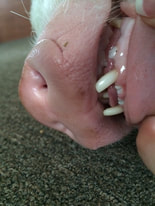
This is a 2 year old pig and her bottom permanent teeth are just erupting. Not every pig will follow the same teething schedule or lose teeth in the same way. Don't be surprised if you find a random tooth every now and again. But, do check your pigs teeth often for plaque buildup and gum disease, abscesses or any abnormalities. If your pig is losing teeth and you think something is wrong, it probably is. Call your vet and see what they recommend. Pigs will loose their teeth at different times, some won't fall out until a new tooth starts to erupt. Do NOT base your pigs dental health on someone else's experience. Just because someone else's pig did not need a cleaning does not mean that your pig doesn't. ALWAYS check with YOUR vet to see what they suggest for YOUR pig.
Having said that, try to desensitize your pig to having her mouth examined by starting it early. Do not put yourself at risk, but try to see if your pig will be agreeable to having her mouth examined. Touch the teeth and tongue. Use flavored teeth wipes on the gums so these things can continue throughout the time your pig is with you.
Having said that, try to desensitize your pig to having her mouth examined by starting it early. Do not put yourself at risk, but try to see if your pig will be agreeable to having her mouth examined. Touch the teeth and tongue. Use flavored teeth wipes on the gums so these things can continue throughout the time your pig is with you.
Mini Pig Tusk Trim
Example Of Tusk Trim/Dental Cleaning
A special Thank You to Teresa Alleva who allowed us to use Pigsby's dental cleaning and tusk trim pictures to show you how this is done professionally. Pigsby stopped eating one day, so she was taken to the vet to see if there was a problem with her teeth. Pigsby's teeth were so bad/long she couldn't close her mouth, they had never been trimmed and it was one of the reasons she was having a hard time eating. These pictures were taken before, during and after the cleaning/trim.
Another special thank you to Kim Sullivan Quinlan for allowing us to use her photographs of her pigs before and after tusk trim. Please take note that the tusks are trimmed leaving some above the gum line. Tusks should NEVER be trimmed TO the gum line. This could potentially expose the pulp leaving an open door for possible tusk root infections. Please be sure your veterinarian knows how to appropriately trim tusks and not assume they do. Clippers should NOT be used, gigli wire or a file can be used, but, water should also be used while this is being done to prevent micro fractures in the tusk. Clippers can fracture the tooth which is why they should not be used on tusks.
Mini Pig Dental Care
Dental Care for Your Pets
Per their dentist’s recommendation, most people brush their teeth twice a day and floss once a day. Practicing regular at-home care and routinely visiting an oral health professional can help prevent bad breath, tooth decay and gum disease. Having good oral hygiene practices is also essential for helping maintain one’s overall health.
Did you know that having good oral hygiene is an important part of your pet’s overall health too? In fact, pets are just as susceptible to the negative repercussions associated with poor oral hygiene as humans are. Unfortunately, few people brush or clean their pet’s teeth as frequently as is recommended — if at all. Here’s a reminder about why it is just as critical for you to practice good oral hygiene habits on your pet as it is to practice them on yourself.
Periodontal Disease
Whether in humans or in animals, periodontal (gum) disease ranges from early-stage gingivitis, which is characterized by gum inflammation, to advanced-stage periodontitis, which is often characterized by damage to the jawbone and soft tissue around the teeth.
The root cause of periodontal disease is plaque buildup around the teeth that gradually spreads under the gum line. When left untreated, bacteria under the gum line can make the problem worse. As it progresses, periodontal disease damages the supporting tissue around the tooth, which can lead to loose teeth that eventually fall out. Furthermore, certain chemicals released by your animal’s own immune system actually speeds up this process.
Thankfully, practicing regular at-home dental care and visiting your veterinarian for regular checkups can help prevent the onset of periodontal disease and other dental diseases in any pet. Use the following guide to keep your pig’s pearly whites sparkling bright.
How to Clean Your Pig’s Teeth
Chew Toys
Chew toys can do more for your pet than satisfy playful tendencies or keep them from chewing your furniture. Some chew toys can actually help build and protect strong teeth. Gnawing on chew toys can eliminate some softer tartar and stimulate your pet’s gums. However, choosing the right chew toy is important.
Make sure you look for pig-safe toys or toxin-free treats if your pet prefers it. If your pet doesn’t particularly like chew toys, make them more inviting by filling them with treats. Many companies even make edible pet chews specifically designed to improve their oral health. Whimzee's are one we recommend for pigs. They are good for, not only your pet’s mouth, but also for their overall health. Chew toys are a great way to bolster your pet’s at-home dental care routine.
If you have any additional questions about your pig’s oral hygiene or would like more information about the correct way to brush your pig’s teeth, contact us or your vet. We can try to brainstorm some ideas with you to try and figure out a plan. Your vet can provide teeth cleanings for your pet, recommend a veterinary dental specialist or simply provide more information about your pig’s oral health.
Common dental problems
Toothache
Have you ever experienced a toothache? This is likely the type of pain that your pet is experiencing on a regular basis because of dental disease. In fact, the discomfort can be severe enough to cause your pet to stop eating and even begin to lose weight. If your pig isn't eating or drinking and a cause has yet to be determined, please check the teeth and be sure there are no abscesses in the mouth, loose teeth or broken teeth.
Periodontal disease
As your pet’s dental disease progresses, periodontal disease begins to occur and affects the tissues surrounding your pet’s teeth. Gingivitis (inflammation of the gums) is one of the first changes to occur. However, the majority of dental disease occurs below the gumline, where a pet owner is unable to actually see the damage being done to their pet’s teeth.
Plaque and tartar
Plaque and tartar begin to build up on your pet’s teeth, affecting not only the tooth itself but the tissue around your pet’s teeth. Tartar and calculi appears as tan or brown colored deposits on your pig's teeth. Pigs CAN get cavities.
Systemic illnesses
Besides being a persistent source of pain for your pet, dental disease can also cause more serious systemic illnesses, such as kidney disease and possibly heart disease. If there is a suspected decay or abscess, please be sure to have this addressed ASAP.
Bad breath
Bad breath (halitosis) is one of the first signs of dental disease in pets. If your pig has breath that smells as though it could knock you over, it’s time to have your pet checked for dental disease.
Retained baby teeth
Also known as retained deciduous teeth, retained baby teeth are commonly seen in pets. If these baby teeth do not fall out normally and are allowed to remain in your pig’s mouth, they can cause crowding because of the extra teeth and can even make it difficult or impossible for the permanent teeth to erupt properly. This can cause pain when eating as well as fractured teeth and even the possibility of multiple teeth falling out at once potentially causing a choking hazard.
Tooth abscess/Tusk abscess
This ia far more common in a male pig whose tusks have been trimmed. It is thought that the pulp of the tooth has been exposed leaving an open area for bacteria to invade the body. These normally have to be managed by your vet and sometimes require extraction to fully treat and correct the underlying issue.
Stomatitis
The inflammation of a pet's oral mucuous membranes, also known as stomatitis, can affect wide portions of the mouth and can be quite painful. Although I haven't heard of a pig with this particular condition, I assume any mammal with teeth can get this.
Proper oral care begins with regular brushing of your pig’s teeth at home. However for pets that simply will not use a toothbrush, there are numerous types of dentrifices available that can help keep the teeth clean. These include chews, special toys, oral rinses and more. Ask your veterinarian for advice about the most appropriate choice for your pig.
A great page to see the tooth eruption is our estimating the age of a pig page, you can go to that page by clicking here.
Per their dentist’s recommendation, most people brush their teeth twice a day and floss once a day. Practicing regular at-home care and routinely visiting an oral health professional can help prevent bad breath, tooth decay and gum disease. Having good oral hygiene practices is also essential for helping maintain one’s overall health.
Did you know that having good oral hygiene is an important part of your pet’s overall health too? In fact, pets are just as susceptible to the negative repercussions associated with poor oral hygiene as humans are. Unfortunately, few people brush or clean their pet’s teeth as frequently as is recommended — if at all. Here’s a reminder about why it is just as critical for you to practice good oral hygiene habits on your pet as it is to practice them on yourself.
Periodontal Disease
Whether in humans or in animals, periodontal (gum) disease ranges from early-stage gingivitis, which is characterized by gum inflammation, to advanced-stage periodontitis, which is often characterized by damage to the jawbone and soft tissue around the teeth.
The root cause of periodontal disease is plaque buildup around the teeth that gradually spreads under the gum line. When left untreated, bacteria under the gum line can make the problem worse. As it progresses, periodontal disease damages the supporting tissue around the tooth, which can lead to loose teeth that eventually fall out. Furthermore, certain chemicals released by your animal’s own immune system actually speeds up this process.
Thankfully, practicing regular at-home dental care and visiting your veterinarian for regular checkups can help prevent the onset of periodontal disease and other dental diseases in any pet. Use the following guide to keep your pig’s pearly whites sparkling bright.
How to Clean Your Pig’s Teeth
- If possible, introduce your pigs to the concept of having their teeth brushed at a young age. Start slowly, so they acclimate to having a toothbrush or finger brush and toothpaste in their mouth. At first, simply put a toothbrush or finger brush with toothpaste on it into your pig’s mouth for 5 seconds at a time. You can slowly increase this amount of time to 2-minute increments, once they become comfortable having a toothbrush and toothpaste in their mouth. We do NOT recommend doing this to an unfamiliar pig or one with behavioral issues. Obviously if there is a chance you will be bit, do not attempt to put your fingers in the mouth. This is accomplished much easier if started when your pig is young.
- As your pig becomes more comfortable with this process, start brushing their teeth. Use your finger or a toothbrush to slowly brush one tooth at a time, focusing on the gum line. The junction of the tooth and gum is one of the most important areas to reach.
- Retract your pig’s lips to create a smile and get to work on the back molars. Spend about 1 minute on the upper row of teeth and another minute on the lower row of teeth. If your pig simply won’t tolerate having his teeth brushed for this long, focus primarily on the upper and outer molars.
- Lastly, make it fun! Use treats or toys to reward your pig.
Chew Toys
Chew toys can do more for your pet than satisfy playful tendencies or keep them from chewing your furniture. Some chew toys can actually help build and protect strong teeth. Gnawing on chew toys can eliminate some softer tartar and stimulate your pet’s gums. However, choosing the right chew toy is important.
Make sure you look for pig-safe toys or toxin-free treats if your pet prefers it. If your pet doesn’t particularly like chew toys, make them more inviting by filling them with treats. Many companies even make edible pet chews specifically designed to improve their oral health. Whimzee's are one we recommend for pigs. They are good for, not only your pet’s mouth, but also for their overall health. Chew toys are a great way to bolster your pet’s at-home dental care routine.
If you have any additional questions about your pig’s oral hygiene or would like more information about the correct way to brush your pig’s teeth, contact us or your vet. We can try to brainstorm some ideas with you to try and figure out a plan. Your vet can provide teeth cleanings for your pet, recommend a veterinary dental specialist or simply provide more information about your pig’s oral health.
Common dental problems
Toothache
Have you ever experienced a toothache? This is likely the type of pain that your pet is experiencing on a regular basis because of dental disease. In fact, the discomfort can be severe enough to cause your pet to stop eating and even begin to lose weight. If your pig isn't eating or drinking and a cause has yet to be determined, please check the teeth and be sure there are no abscesses in the mouth, loose teeth or broken teeth.
Periodontal disease
As your pet’s dental disease progresses, periodontal disease begins to occur and affects the tissues surrounding your pet’s teeth. Gingivitis (inflammation of the gums) is one of the first changes to occur. However, the majority of dental disease occurs below the gumline, where a pet owner is unable to actually see the damage being done to their pet’s teeth.
Plaque and tartar
Plaque and tartar begin to build up on your pet’s teeth, affecting not only the tooth itself but the tissue around your pet’s teeth. Tartar and calculi appears as tan or brown colored deposits on your pig's teeth. Pigs CAN get cavities.
Systemic illnesses
Besides being a persistent source of pain for your pet, dental disease can also cause more serious systemic illnesses, such as kidney disease and possibly heart disease. If there is a suspected decay or abscess, please be sure to have this addressed ASAP.
Bad breath
Bad breath (halitosis) is one of the first signs of dental disease in pets. If your pig has breath that smells as though it could knock you over, it’s time to have your pet checked for dental disease.
Retained baby teeth
Also known as retained deciduous teeth, retained baby teeth are commonly seen in pets. If these baby teeth do not fall out normally and are allowed to remain in your pig’s mouth, they can cause crowding because of the extra teeth and can even make it difficult or impossible for the permanent teeth to erupt properly. This can cause pain when eating as well as fractured teeth and even the possibility of multiple teeth falling out at once potentially causing a choking hazard.
Tooth abscess/Tusk abscess
This ia far more common in a male pig whose tusks have been trimmed. It is thought that the pulp of the tooth has been exposed leaving an open area for bacteria to invade the body. These normally have to be managed by your vet and sometimes require extraction to fully treat and correct the underlying issue.
Stomatitis
The inflammation of a pet's oral mucuous membranes, also known as stomatitis, can affect wide portions of the mouth and can be quite painful. Although I haven't heard of a pig with this particular condition, I assume any mammal with teeth can get this.
Proper oral care begins with regular brushing of your pig’s teeth at home. However for pets that simply will not use a toothbrush, there are numerous types of dentrifices available that can help keep the teeth clean. These include chews, special toys, oral rinses and more. Ask your veterinarian for advice about the most appropriate choice for your pig.
A great page to see the tooth eruption is our estimating the age of a pig page, you can go to that page by clicking here.
Mini Pig Dental Cleaning
Thanks to Renee Lincoln for sharing Melvin's dental cleaning pictures with us. Melvin has regular dental check up's at his mom's workplace where she works as a vet tech.
Recommended Products For Mini Pig Dental Care
|
A couple of items are recommended for use in pigs to help with tarter/plaque buildup. Whimzee's are one, however, they can get lodged in the throat and because they're so rigid, they can easily scratch the esophagus as they are swallowed. Recently, I was made aware of an oral chew that was created to help control the buildup in the mouth. This chew can be prescribed by your veterinarian. Oravet, definitely something to consider.
I have been using these for my own pig for 2 months now and cannot even describe the difference in my pigs overall teeth AND breath! Amazing. I would absolutely recommend these to anyone who is considering what can be used for good oral hygiene. |
Mini Pig Tusk Care
What should I do about my pig's tusks?
"All pigs grow tusks". This, of course, includes potbelly pigs and all the other breeds commonly seen as pets. Female potbellied pigs grow smaller tusks that rarely get large enough to stick out of their mouth, but since each pig is different, there are some female spayed pigs that have longer tusks. Females tusks stop growing at maturity and the tusk root closes. Neutered males will have a nice set of tusks that grow large enough to protrude from the mouth. This will start to happen at about two years of age. Male tusks never stop growing, their tusk root does NOT close like the females, so they will need tusk trims for the rest of their lives if the tusks grow in a way that requires trimming or your pig doesn't practice awareness and the tusks have caused or may cause injury. Males are predisposed to tusk root abscesses due to trimming them and exposing the pulp. Tusk root infections are not typically seen in female pigs because normally females tusks don't need to be or aren't trimmed. If your pig has tusks that aren't growing in a way that will injure you or the pig himself, a tusk trim is not recommended.
Tusks need not be trimmed unless they are causing a problem for the pig or you. Do not attempt to cut tusks yourself. Please let a professional trim the tusks unless you are experienced. NEVER let anyone trim the tusks if the pig is awake and screaming. He can accidentally inhale the tusk. Tusk trimming is best done, by your vet, while using Isofluorine gas anesthesia. Make sure that at least 1/2 inch or more of tusk is left. Mini pigs that have had a tusk trim have a tendency to become infected if the tusk trimmed is too close to the gum line. Also, DO NOT allow anyone remove the tusks!! They are part of the jawbone and removal will cause serious problems! If at all possible, avoid trimming your male's tusks for the reasons stated above.
We know that nippers or clippers leave the teeth with breaks, cracks and tooth fractures and should never be a way you trim tusks. We also know you should never trim the tusk below the lip line. Gigli wire is the way to go .... BUT.... BUT.... BUT.... as they're cut, there needs to be cool water dropped onto the area!!!!!!!!!!!!!!!!!!!!!!!!!! Many people and vets may have already known this, but for those who didn't, this may need to be a conversation you have with your vet to find out their standard procedure for tusk trims. Some university veterinarians say since they have been using this water cooling method, they haven't had any further problems with tusk infections.
It appears the problem is as the tusk is cut, the friction causes heat. That heat travels down the tooth to the pulp. The pulp becomes sort of "cooked" and turns necrotic. This starts an infection. The damage done to the pulp is cumulative and generally cannot regenerate.
After consulting with a human dentist, he confirmed that they do use water in order to prevent killing the tooth from the heat. The same methods that are used in human dentistry can also be used in pig dentistry to protect the teeth from fractures and root infections.
Written by: Brittany Sawyer and Cat Drose
Tusks need not be trimmed unless they are causing a problem for the pig or you. Do not attempt to cut tusks yourself. Please let a professional trim the tusks unless you are experienced. NEVER let anyone trim the tusks if the pig is awake and screaming. He can accidentally inhale the tusk. Tusk trimming is best done, by your vet, while using Isofluorine gas anesthesia. Make sure that at least 1/2 inch or more of tusk is left. Mini pigs that have had a tusk trim have a tendency to become infected if the tusk trimmed is too close to the gum line. Also, DO NOT allow anyone remove the tusks!! They are part of the jawbone and removal will cause serious problems! If at all possible, avoid trimming your male's tusks for the reasons stated above.
We know that nippers or clippers leave the teeth with breaks, cracks and tooth fractures and should never be a way you trim tusks. We also know you should never trim the tusk below the lip line. Gigli wire is the way to go .... BUT.... BUT.... BUT.... as they're cut, there needs to be cool water dropped onto the area!!!!!!!!!!!!!!!!!!!!!!!!!! Many people and vets may have already known this, but for those who didn't, this may need to be a conversation you have with your vet to find out their standard procedure for tusk trims. Some university veterinarians say since they have been using this water cooling method, they haven't had any further problems with tusk infections.
It appears the problem is as the tusk is cut, the friction causes heat. That heat travels down the tooth to the pulp. The pulp becomes sort of "cooked" and turns necrotic. This starts an infection. The damage done to the pulp is cumulative and generally cannot regenerate.
After consulting with a human dentist, he confirmed that they do use water in order to prevent killing the tooth from the heat. The same methods that are used in human dentistry can also be used in pig dentistry to protect the teeth from fractures and root infections.
Written by: Brittany Sawyer and Cat Drose
Tusk trimming:
Females AND males do get tusks. Neutered and spayed pigs do get tusks. However, tusk growth is fueled by testosterone. Therefore an intact boar is going to have the FASTEST tusk growth, a neutered male and intact sow will be slower growth, and a spayed female will have the slowest tusk growth. Instead of removing the tusk teeth, you may choose to have your vet file or clip them periodically. Removing them would compromise the entire jaw since the tusk is a part of the jaw. The frequency of tusk trims will depend on your individual pig, the rate your pig grows the tusks, and the risk to others. Some people never trim tusks. They prefer to leave the tusks natural. Families with other pets or small children may find tusks to be a danger, either by an aggressive act from the pig or by simply running too close to someone or rubbing against their leg-serious bodily damage can occur from these sharp teeth. Most people start trimming their pig's tusks between 1 and 3 years of age. Some have yearly tusk trims, others follow their own schedule on an "as needed" basis. Some tusks can grow at a bad angle until they actually pierce the cheek or upper lip of the pig. In this case, tusk trimming is not optional and must be maintained for the health and welfare of the pig.
Schedule an appointment with your veterinarian to discuss tusk trimming and whether or not your vet feels like a tusk trim is necessary. You should never trim tusks of a pig while awake. If they are screaming and inhale a piece of tusk you're gonna have big problems. They also stress easily and can suffer from Porcine Stress Syndrome. They can literally die from stress. I understand some people will restrain the frantic pigs for hoof trimming and tusk trimming, but the pig feels like he is fighting for his life. His instincts kick in and emotions take over, that takes quite a toll on them. As we know how smart pigs are they are going to remember that restraint and will be more cautious to avoid the trauma in the future, causing even more difficulty getting him to a vet or other basic care done. Isoflourane gas is the safest anesthesia for pigs, but it is expensive and not feasible for traveling veterinarians. Other anesthesia or sedatives may be used, but are typically more of a risk. Discuss options with your veterinarian.
Dental care is extremely important for potbellied pigs. Newborn pigs should have their 8 needle teeth trimmed to prevent injury to litter mates and cuts on their mother's breasts and underside. At about 5 to 7 months of age, the permanent canine teeth will erupt. These canine teeth grow continuously throughout the pig's life. They should be first trimmed at about 1 year of age and then trimmed on an annual basis. Without trimming, the canine teeth will become elongated and cause discomfort and a misaligned bite. Pigs with elongated canine teeth may show persistent chewing motions and heavy salivation. Tooth trimming requires sedation or anesthesia and is often accompanied by a tetanus vaccination and removal of accumulated tartar and other debris from around other teeth to maintain good dental hygiene.
Source: http://www.merckmanuals.com/pethealth/exotic_pets/potbellied_pigs/routine_health_care_of_potbellied_pigs.html
Permanent teeth erupt between 8-20 months of age. Dental formula for permanent teeth: 2(I 3/3; C 1/1; P4/4; M 3/3 = 44). Tusks erupt at 10-15 months and continue to grow throughout life. Complete tusk removal is very difficult because of deep embedded roots. Trimming the tusks one inch above the gingival level is recommended using gigli wire under general anesthesia. Tusks should be trimmed on a plane perpendicular to their growth rather than cutting along the plane of the gum line as this may lead to improper regrowth and difficulty in mastication. Sharp edges may remain and should be removed with a rasp. Tusks should not be trimmed with clippers as this may cause fracture of the tooth root.
~Dr. VanAmstel
Tusk removal: No. No, no, no, please don't. A pig's tusks are rooted INTO the jaw bone requiring surgery and there is a risk of breaking the jaw bone. Even if the jaw bone is not broken during tusk removal surgery the bone may be weaker for the life of the pig causing future breaks and infection risk more likely. Females AND males do get tusks. Neutered and spayed pigs do get tusks. However, tusk growth is fueled by testosterone. Therefore an intact boar is going to have the FASTEST tusk growth, a neutered male and intact sow will be slower growth, and a spayed female will have the slowest tusk growth. Females tusk root closes at maturity and the tusk does not grow anymore. Male pigs tusk root never closes, therefore they will require tusk trims their entire lives IF a tusk trim is needed. Instead of removing the tusk teeth you may choose to have your vet file or clip them periodically. By the time your pig is a year old, you may want to think about having the tusks trimmed. Hopefully you've touched the mouth and gums and your pig is comfortable with the teeth/tusks being handled. Its best to do this while they're young so this isn't a traumatic experience for them later in life. Please see the pictures below that demonstrate how the tusk is, in fact, part of the jaw and can not be removed without compromising the entire mandible.
Females AND males do get tusks. Neutered and spayed pigs do get tusks. However, tusk growth is fueled by testosterone. Therefore an intact boar is going to have the FASTEST tusk growth, a neutered male and intact sow will be slower growth, and a spayed female will have the slowest tusk growth. Instead of removing the tusk teeth, you may choose to have your vet file or clip them periodically. Removing them would compromise the entire jaw since the tusk is a part of the jaw. The frequency of tusk trims will depend on your individual pig, the rate your pig grows the tusks, and the risk to others. Some people never trim tusks. They prefer to leave the tusks natural. Families with other pets or small children may find tusks to be a danger, either by an aggressive act from the pig or by simply running too close to someone or rubbing against their leg-serious bodily damage can occur from these sharp teeth. Most people start trimming their pig's tusks between 1 and 3 years of age. Some have yearly tusk trims, others follow their own schedule on an "as needed" basis. Some tusks can grow at a bad angle until they actually pierce the cheek or upper lip of the pig. In this case, tusk trimming is not optional and must be maintained for the health and welfare of the pig.
Schedule an appointment with your veterinarian to discuss tusk trimming and whether or not your vet feels like a tusk trim is necessary. You should never trim tusks of a pig while awake. If they are screaming and inhale a piece of tusk you're gonna have big problems. They also stress easily and can suffer from Porcine Stress Syndrome. They can literally die from stress. I understand some people will restrain the frantic pigs for hoof trimming and tusk trimming, but the pig feels like he is fighting for his life. His instincts kick in and emotions take over, that takes quite a toll on them. As we know how smart pigs are they are going to remember that restraint and will be more cautious to avoid the trauma in the future, causing even more difficulty getting him to a vet or other basic care done. Isoflourane gas is the safest anesthesia for pigs, but it is expensive and not feasible for traveling veterinarians. Other anesthesia or sedatives may be used, but are typically more of a risk. Discuss options with your veterinarian.
Dental care is extremely important for potbellied pigs. Newborn pigs should have their 8 needle teeth trimmed to prevent injury to litter mates and cuts on their mother's breasts and underside. At about 5 to 7 months of age, the permanent canine teeth will erupt. These canine teeth grow continuously throughout the pig's life. They should be first trimmed at about 1 year of age and then trimmed on an annual basis. Without trimming, the canine teeth will become elongated and cause discomfort and a misaligned bite. Pigs with elongated canine teeth may show persistent chewing motions and heavy salivation. Tooth trimming requires sedation or anesthesia and is often accompanied by a tetanus vaccination and removal of accumulated tartar and other debris from around other teeth to maintain good dental hygiene.
Source: http://www.merckmanuals.com/pethealth/exotic_pets/potbellied_pigs/routine_health_care_of_potbellied_pigs.html
Permanent teeth erupt between 8-20 months of age. Dental formula for permanent teeth: 2(I 3/3; C 1/1; P4/4; M 3/3 = 44). Tusks erupt at 10-15 months and continue to grow throughout life. Complete tusk removal is very difficult because of deep embedded roots. Trimming the tusks one inch above the gingival level is recommended using gigli wire under general anesthesia. Tusks should be trimmed on a plane perpendicular to their growth rather than cutting along the plane of the gum line as this may lead to improper regrowth and difficulty in mastication. Sharp edges may remain and should be removed with a rasp. Tusks should not be trimmed with clippers as this may cause fracture of the tooth root.
~Dr. VanAmstel
Tusk removal: No. No, no, no, please don't. A pig's tusks are rooted INTO the jaw bone requiring surgery and there is a risk of breaking the jaw bone. Even if the jaw bone is not broken during tusk removal surgery the bone may be weaker for the life of the pig causing future breaks and infection risk more likely. Females AND males do get tusks. Neutered and spayed pigs do get tusks. However, tusk growth is fueled by testosterone. Therefore an intact boar is going to have the FASTEST tusk growth, a neutered male and intact sow will be slower growth, and a spayed female will have the slowest tusk growth. Females tusk root closes at maturity and the tusk does not grow anymore. Male pigs tusk root never closes, therefore they will require tusk trims their entire lives IF a tusk trim is needed. Instead of removing the tusk teeth you may choose to have your vet file or clip them periodically. By the time your pig is a year old, you may want to think about having the tusks trimmed. Hopefully you've touched the mouth and gums and your pig is comfortable with the teeth/tusks being handled. Its best to do this while they're young so this isn't a traumatic experience for them later in life. Please see the pictures below that demonstrate how the tusk is, in fact, part of the jaw and can not be removed without compromising the entire mandible.
Tusk Injuries Caused By Pigs
Injuries caused by the tusk of pet pigs (accidental or purposeful)
The majority of tusk injuries are not caused on purpose, even when dealing with an aggressive pig. Accidents happen, but it is EXTREMELY important to have these injuries checked by a doctor because infection can rear its ugly head within HOURS. The area is expected to be red, sometimes swollen and this is the body's natural reaction to a foreign entity that has pierced the skin. However, if not cleaned by a professional or done well, this has opened the door for bacteria to enter the skin and cause massive infection and/or other issues depending on where the tusk entered the skin, how deep it went and what bacteria were present.
There have been times when arteries have been nicked, there have been times when muscle has been punctured and it is painful. Typically, any animal "bite", accidental or not, will require a course of antibiotics, to be on the safe side, in addition to a tetanus vaccine if it has been a while since you have received one. Tetanus is a slow moving disease, but can be fatal if untreated. Your doctor may report this injury to your animal control and your pig may be quarantined as a precaution, but depending on the circumstances and animal control organization (or your doctor reporting the animal bite) this can be done in a way that doesn't interrupt your pigs routine. Always follow your doctor's advice, as well as any animal control procedures they determine to be appropriate for the situation. This is one case where it is beneficial to have your pig vaccinated for Rabies. Even though there isn't an approved vaccination specifically for pigs, it is used off label to vaccinate pigs in many areas. Some cities require a rabies vaccination in order to be in compliance with their ordinance. Having your pig vaccinated can prevent a lot of heartache.
There have been times when arteries have been nicked, there have been times when muscle has been punctured and it is painful. Typically, any animal "bite", accidental or not, will require a course of antibiotics, to be on the safe side, in addition to a tetanus vaccine if it has been a while since you have received one. Tetanus is a slow moving disease, but can be fatal if untreated. Your doctor may report this injury to your animal control and your pig may be quarantined as a precaution, but depending on the circumstances and animal control organization (or your doctor reporting the animal bite) this can be done in a way that doesn't interrupt your pigs routine. Always follow your doctor's advice, as well as any animal control procedures they determine to be appropriate for the situation. This is one case where it is beneficial to have your pig vaccinated for Rabies. Even though there isn't an approved vaccination specifically for pigs, it is used off label to vaccinate pigs in many areas. Some cities require a rabies vaccination in order to be in compliance with their ordinance. Having your pig vaccinated can prevent a lot of heartache.

